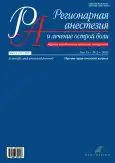Comparative analysis of visual analog scales for assessing acute pain in women after radical mastectomy
- Authors: Yaskevich V.V.1, Marochkov A.V.2
-
Affiliations:
- Healthcare Institution “Bobruisk Interdistrict Oncologic Dispensary”
- Healthcare Institution “Mogilev Regional Clinical Hospital”
- Issue: Vol 15, No 2 (2021)
- Pages: 153-162
- Section: Original articles
- URL: https://journals.rcsi.science/1993-6508/article/view/90119
- DOI: https://doi.org/10.17816/1993-6508-2021-15-2-153-162
- ID: 90119
Cite item
Abstract
BACKGROUND: Effective quantitative assessment of acute pain as an urgent problem in clinical medicine. One of the solutions to this problem is a color discrete scale (CDS).
AIM: To determine the efficacy of the clinical usage of color discrete scale compared with linear visual analog scale to assess acute pain in women after radical mastectomy.
MATERIALS AND METHODS: This study includes a prospective, observational, and non-randomized clinical trial. A total of 110 females who underwent radical mastectomy (RM) were interviewed. We used a 100-point linear visual analog scale (lVAS) and CDS with monotonic (mCDS) and random (rCDS) color arrangement. Pain was assessed 2, 6, 12, 24, 48, and 72 h after surgery.
RESULTS: Pain scores obtained 2 h after RM were 6 (0; 30), 12 (0; 24), 8 (0; 20) points according to IVAS, mCDS, and rCDS, respectively (p >0.05). Furthermore, the pain scores were gradually reduced on all three scales and had no statistically significant difference (p >0.05). In women who underwent paravertebral blockade (PVB), pain scores were significantly less at 2, 6, 12, and 48 h after surgery (p <0.05). Spearman’s correlation coefficient for lVAS and mCDS is 0.90, 0.86 for lVAS and rCDS, and 0.90 for mCDS and rCDS (all p <0.05).
CONCLUSIONS: The CDS is an alternative, independent, and sufficient tool for quantifying pain. A strong correlation was found between the pain assessments according to CDS and lVAS. PVB significantly improves the quality of pain relief after RM.
Full Text
##article.viewOnOriginalSite##About the authors
Valery V. Yaskevich
Healthcare Institution “Bobruisk Interdistrict Oncologic Dispensary”
Author for correspondence.
Email: varera@tut.by
ORCID iD: 0000-0001-7428-7823
anaesthesiologist-resuscitator
Belarus, BobruiskAlexey V. Marochkov
Healthcare Institution “Mogilev Regional Clinical Hospital”
Email: varera@tut.by
ORCID iD: 0000-0001-5092-8315
MD, PhD, DSc, Professor
Belarus, MogilevReferences
- Gerasimov AA. O stadijah razvitija hronicheskogo bolevogo sindroma. Russian Journal of Pain. 2016;2:14–5 (In Russ).
- Milushkina OI, Peskov AB, Galushina IA. Algometric possibilities of the computer electroacupuncture аt the chronic abdominal pain. Journal of New Medical Technologies. 2008;15(2):152–4 (In Russ).
- Mokhov EM, Kadykov VA, Sergeev AN, et al. Pain scoring systems and their application features in medicine (literature review). Upper Volga Medical Journal. 2019;18(2):34–7 (In Russ).
- de Jesus JAL, Campos Júnior D, Storm H, et al. Skin conductance and behavioral pain scales in newborn infants. Psychol Neurosci. 2015;8(2):203–10. doi: 10.1037/h0101058
- Fratino S, Peluso L, Talamonti M, et al. Evaluation of Nociception Using Quantitative Pupillometry and Skin Conductance in Critically Ill Unconscious Patients: A Pilot Study. Brain Sci. 2021;11:109. doi: 10.3390/brainsci11010109
- Levina GY, Bykov YN, Borisov AS. Diagnostics and therapy of peripheral neuropathy (literature review). Acta Biomedica Scientifica (East Siberian Biomedical Journal). 2015.1:72–6 (In Russ).
- Morozov AM, Zhukov SV, Belyak MA, et al. About the possibilities of evaluating a pain syndrome using the most validized pain scales. Journal of New Medical Technologies. 2020;27(2):62–8 (In Russ).
- Popadyuk VI, Kastyro IV, Chuluunbaatar SS, Drozdova GA. Age-specificity in acute pain syndrome measurement in otorhinolaryngology. RUDN Journal of Medicine. 2012;(2):94–9 (In Russ).
- Zabolotskikh IB, Gorobets ES, Grigor’ev EV, et al. Perioperative management of geriatric patients. Russian Journal of Anаеsthesiology and Reanimatology. 2018;(1):5–20. doi: 10.17116/anaesthesiology201801-0215 (In Russ).
- Marochkov AV, Iakimov DA. Evaluation of the efficiency of using two different visual scales for quantitative measurement of acute pain. Russian journal of Anaesthesiology and Reanimatology. 2008;4:50–52 (In Russ).
- Ovechkin AM. Chronic postoperative pain syndrome – «a pitfall» of modern surgery. Regional Anesthesia and Acute Pain Management. 2016;10(1):5–18. doi: 10188.21/1993-6508-2016-10-1-5-18 (In Russ).
- Gerbershagen HJ, Aduckathil S, van Wijck AJ, et al. Pain intensity on the first day after surgery: a prospective cohort study comparing 179 surgical procedures. Anesthesiology. 2013;118(4):934–944. doi: 10.1097/ALN.0b013e31828866b3
- Jaffe RA, Golianu B, Schmiesing CA, editors. Anesthesiologist’s manual of surgical procedures. Lippincott: Williams & Wilkins; 2014.
- Khoronenko VE, Malanova AS, Baskakov DS, et al. Regional and peripheral blockades for prevention of chronic post-thoracotomy pain syndrome in oncosurgical practice. Pirogov Russian Journal of Surgery. 2017;(8):58–63. doi: 10.17116/hirurgia2017858-63 (In Russ).
- Tishkov DS, Bobyncev II. The study of the level of intensity of pain in patients with trigeminal neuralgia on the background of complex therapy phisiobalneotherapy. Physiotherapist. 2016;(2):23–28. (In Russ).
- Morozov AM, Sergeev AN, Zhukov SV, et al. About the possibility of using scales of pain in the conditions of a hospital. Modern problems of science and education. 2020;(4):148. doi: 10.17513/spno.29862 (In Russ).
- Le May S, Ballard A, Khadra C, et al. Comparison of the psychometric properties of 3 pain scales used in the pediatric emergency department: Visual Analogue Scale, Faces Pain Scale-Revised, and Colour Analogue Scale. Pain. 2018;159(8):1508–1517. doi: 10.1097/j.pain.0000000000001236
- Nesteruk SF, Marochkov AV, Marochkova NA. Kolichestvennaya otsenka vospriyatiya ostroy boli u beremennykh. Okhrana materinstva i detstva. 2011;(2):65–69 (In Russ).
Supplementary files









